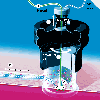21st Century Bloodsucker
Medical invention: Doctors unveil the latest in mechanical parasites.

Illustration by Garry Marshall
A mechanical leech might be better than the real thing in helping wounds heal. Here’s how it works:
1. Tube delivers a solution containing Heparin, an anticoagulant, to the wound.
2. Miniature bellows move the tube up and down, preventing blood from clotting at the bottom.
3. Actuator-driven disk rotates tube, also to prevent clotting.
4. Holes in the cone release the solution to cleanse wound.
5. Suction draws blood and solution out to promote circulation.
“Leech” is derived from an old English word meaning “physician,” and in the practice of Dr. Gregory Hartig, based in Madison, Wisconsin, that makes sense. After performing a reconstructive surgery, Hartig still sometimes prescribes leeches. From prehistory to the present, the bloodsucking worms have been applied to treat everything from cancer to broken bones. Modern research has shown that leeches help blood circulate and prevent clots. The problem, according to Hartig, is that many patients don’t like the idea of carnivorous parasites biting into their flesh and slurping down their blood. Moreover, leeches must be replaced every hour or so, after they’ve drunk their fill. And unless they are closely monitored, they can wander around and attack healthy tissue. On occasion, they’ve also been known to transmit bacterial infections.
Hartig decided there ought to be a less disgusting alternative, and so he and his collaborators have developed a mechanical leech. The business end of the device is a Teflon-coated cone that is inserted beneath a patient’s skin. The device can remove blood from a larger area than a real leech can, and should be cheaper to use, since live leeches (which cost about $7 apiece) require so much attention from nurses.
So far, the device has been tested only on pigs, whose skin is similar to that of humans. The research team-which includes veterinarian Michael Conforti and research scientist Nadine Connor-is working to make the mechanical leech smaller and easier to use. They say it should be ready for human patients within the next three years.